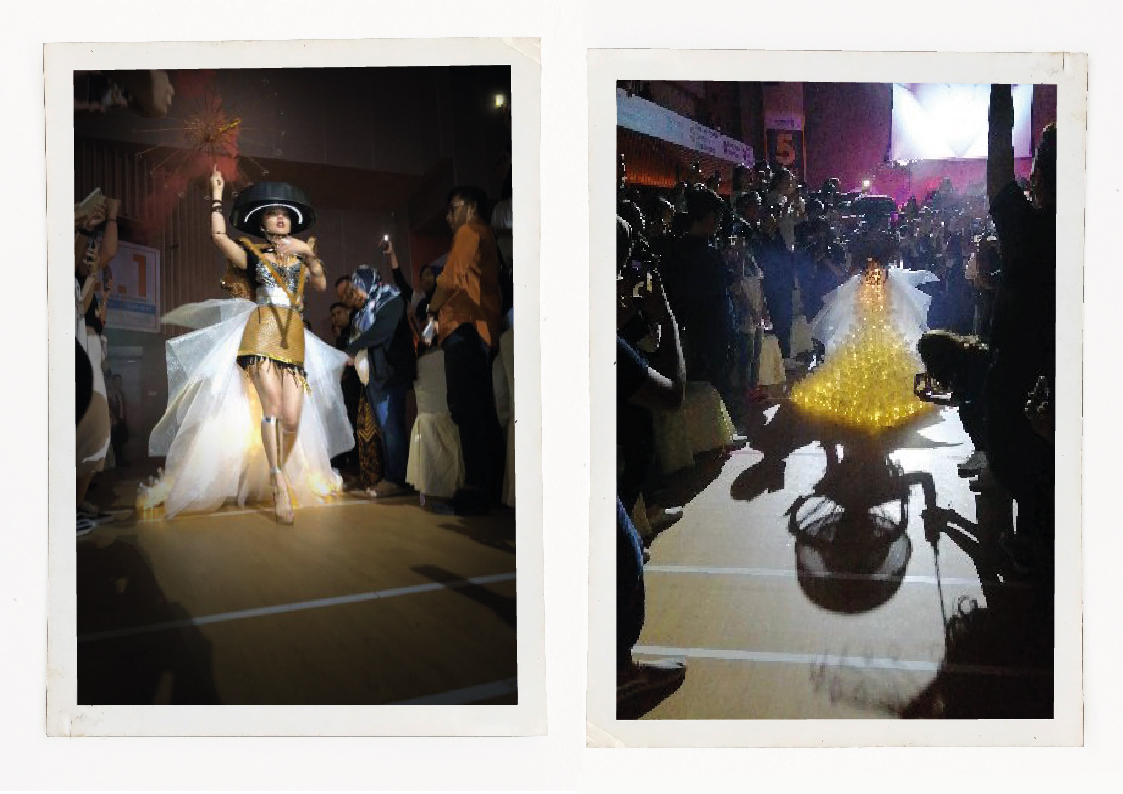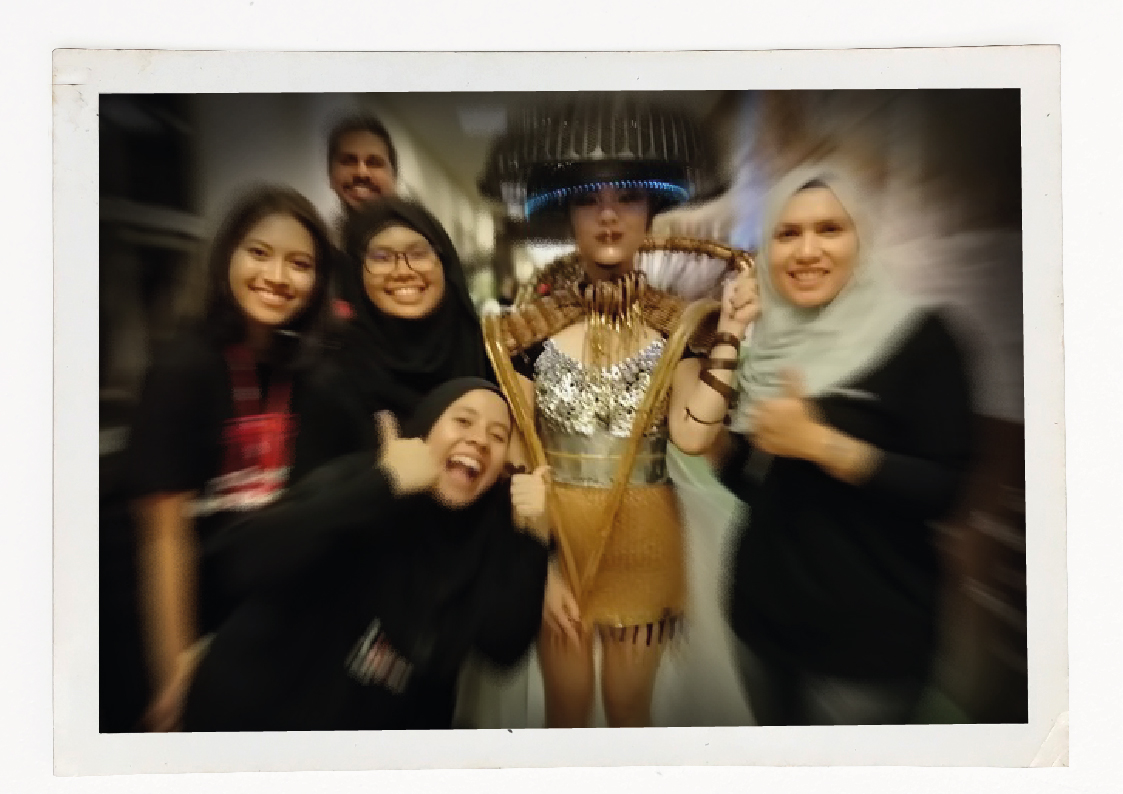A group of interior design students and staff from Taylor’s University participated in a fashion competition based on the theme: Deria Gaya (Sense of Style) in 2018. The host for this event was Sunway University.
The students were challenged to create a garment based on the sensory experience of being enveloped while bearing in mind Malaysian heritage with sustainable and upcycled materials. This category exposed the students to issues of sustainability and functional design.
The team of 5 including 3 students and 2 advisors/lecturers, brainstormed ideas of avant-garde fashion design to unlock ideas inspired from various aspects of Malaysian culture such as fishermen and farmers’ working tools and equipment, and even local delicacies. The idea was to not only retain a distinct local Malaysian identity but also to capture the avant-garde spirit of being enveloped by the garment. Students collected available recycled materials from many sources such as items from their own kitchens, backyards, or even materials from the recycling centre. However, the competition brief was precise in its requirement of upcycling-recycled materials in the design. The students immediately had to learn the difference between recycled and upcycled:
Recycling turns waste into a reusable product or refurbishes a product for reuse. Upcycling is a particular form of recycling that involves turning waste material or an unwanted product into a better-quality product. (Intercongreen, 2010)
The first recycled material the team considered were plastic drinking bottles based on the research previously done on recycled materials. They found their inspiration in the Vestito Blu by Enrica Borghi (Abraham, 2010). The dress, entirely held together by plastic bottles, created an ethereal feeling where the deep blue of the bottles seemed translucent, opaque, and solid all at the same time. As such, the team decided that plastic bottles were the best recycled material to use to become the “fin” of the garment that would ensure a lofty and graceful walk by the model akin to wedding dresses wherein the nature of the walk is delicate as opposed to high fashion shows where the models’ walk with a certain aggression. In addition, the team considered utilizing the character of plastic as transparent and translucent as well as disposable — people buy the bottles only for water consumption and then throw them away on a daily basis. Thus, they considered the upcycling of the plastic drinking bottles as an ode to sustainability.
The use of plastic bottles as well as other types of domestic plastics have become an environmental threat. Therefore, the upcycling of the water bottles would ennoble the garment to showcase it as wearable art — a rebel with an important cause.
Examining the various ways they could manipulate the translucent character of the plastic into the design, they found that best way to highlight the materiality of the bottles was to highlight its translucency by including lighting (probably colored) underneath it. They decided that the use of fairy lights would allow for individual highlighting of each bottle to bring about a surreal feeling due to the abundance of lights in a wearable piece of art. Effects could change when the lighting was switched on in the dark and would definitely capture the audience’s attention.
Aluminum cans were also used to support the design concept through their shiny, silvery character that would contrast with the materials that were darker in the design. Upcycling the aluminum cans was laborious since it was difficult to cut the aluminum cans without cutting themselves. The combination and contrast of the silvery cans and the shining rings surrounding them brought about an intricacy to the garment that reflected the use of pattern and texture in traditional Malaysian crafts and thus increased the narrative of a sustainable Malaysian avant-garde design.
The ‘tudung saji’, a traditional food covering used in Malay culture to protect meals typically uses a multitude of patterns such as the triaxial or hexagonal weave, however, more modern forms of the food cover are typically done in a simpler manner. The student design drew upon the uniqueness of the traditional ‘tudung saji’ by using the dome shape typically made of locally processed rattan whereby the natural brown color created an edgy contrast to the sleek coolness of the aluminum cans, though the ‘tudung saji’ used in this design was spray-painted black to match the garment.
By chance, one of the team members had a broken lazy chair made out of rattan and bamboo that had been they bent and shaped to work perfectly for the top. Additionally, they upcycled a rattan woven bag that inspired the shape of the skirt to offer a detail of contrasting colors and materiality.
Inspired by one of the avant-garde ideas from a dress worn by Grace Jones at the Grammy Awards, the students included a plastic‘tudung saji’ supported with a built-in mechanism that spun manually. The top of the ‘tudung saji’ was fitted with a smaller one below that included a lighting strip to enhance the lower unmovable headgear. To complete the garment, the team added Nyonya Baba wooden umbrella made into a skeleton lattice as part of a unique accessory for the model.

The design ideas did not come immediately. The availability of the materials somehow nurtured the ideas that came piece by piece. All the different techniques of assembling the materials together were knowledge that derived upon iterations of research and trials. At the end of the whole process, which took a month to complete, the garment transformed into a beautiful design attire, fit for a warrior princess!
The team enjoyed the competition and were amazed at how the garment managed to glide gracefully along the runway despite all the bottles and cans. The confident runway model, our very own interior architecture student, successfully presented the garment in a professional way. The best of all given is that we had no prior experience in designing fashion and definitely were not skilled in aspects of garment production, however, all the hard work and effort paid off when we were awarded the first prize for the design!

References
Intercongreen (2010) Recycling vs. Upcycling: What is the difference, Retrieved from: https://intercongreen.com/2010/02/17/recycling-vs-upcycling-what-is-the-difference/
Abraham, M (2010) What Does Plastic Have to Do with Art? Retrieved from: https://blogs.getty.edu/iris/what-does-plastic-have-to-do-with-art/


You must be logged in to post a comment.